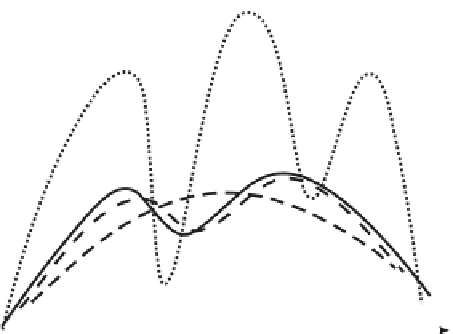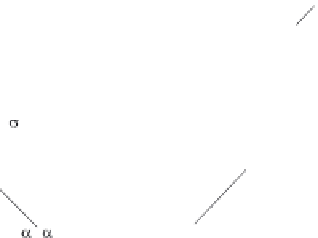Information Technology Reference
In-Depth Information
consisting of the misfit functional I(
) and the stabilizing functional
(
). The
solution of this inverse problem reduces to the minimization of
(
), that is, to
the minimization of I(
). Whereas the initial problem (10.1) is unsta-
ble, the solution obtained by minimizing the functional
) and
(
is stable with respect
to small variations in [
Z
] and
˜
W
. The point is that the functional
) narrows
the class of possible solutions and stabilizes the problem. It is given the name the
stabilizer.
The structure of the misfit functional I(
(
) depends on the inversion strategy. It
can be a functional (10.62) of total misfit, when carrying out the magnetotelluric and
magnetovariational inversions in parallel, or fuctionals (10.63) of partiall misfits,
when accomplishing successive inversions.
The structure of the stabilizing functional
) depends on a priori restraints
imposed on the inverse problem. It can be, for example, the requirement of smooth-
ness of
(
(
x
,
y
,
z
) satisfied by minimizing the functional
2
dxdydz
2
2
(
)
=
+
+
(10
.
72)
x
y
z
V
or the requirement of closeness of
(
x
,
y
,
z
) to a hypothetical model
0
(
x
,
y
,
z
)
satisfied by minimizing the functional
2
dxdydz
(
)
=
{
(
x
,
y
,
z
)
−
0
(
x
,
y
,
z
)
}
.
(10
.
73)
V
The weight of the stabilizing functional, i.e., the degree of its effect on the
solution of an inverse problem, is controlled by the regularization parameter
(Fig. 10.5). At large
, the minimization of
(
) leads to the dominating
minimization of
(
), i.e., oversmoothes the solution or retains it near the a priori
<
opt
Fig. 10.5
Dependence of the
solution of an inverse
problem on the regularization
parameter
=
opt
>
opt
;¯
is an exact
z
model solution








